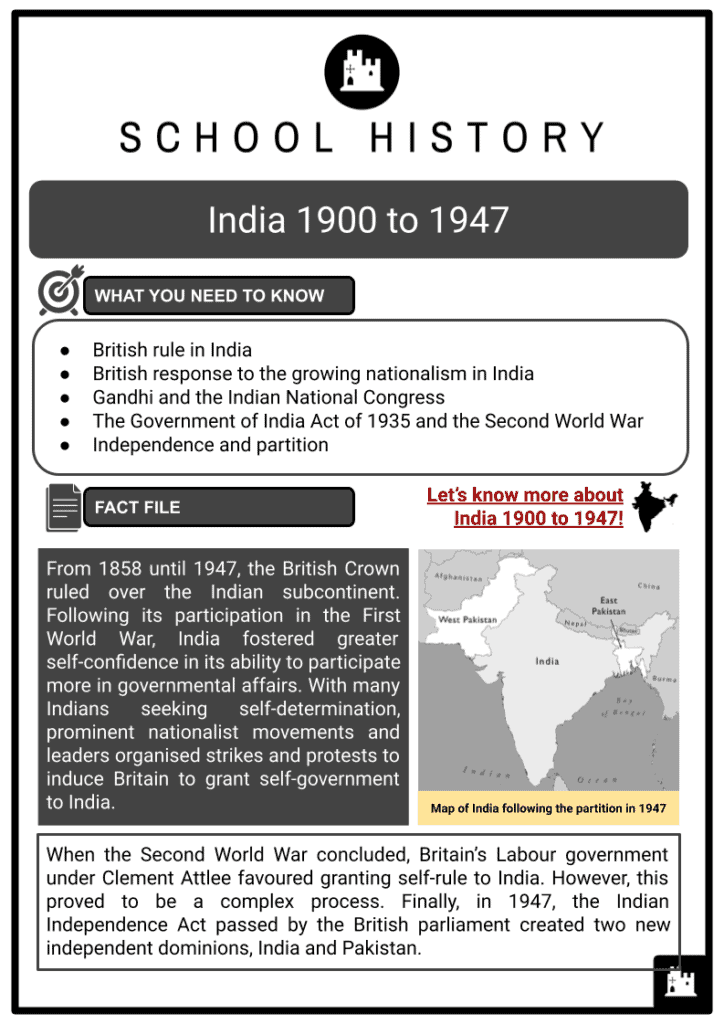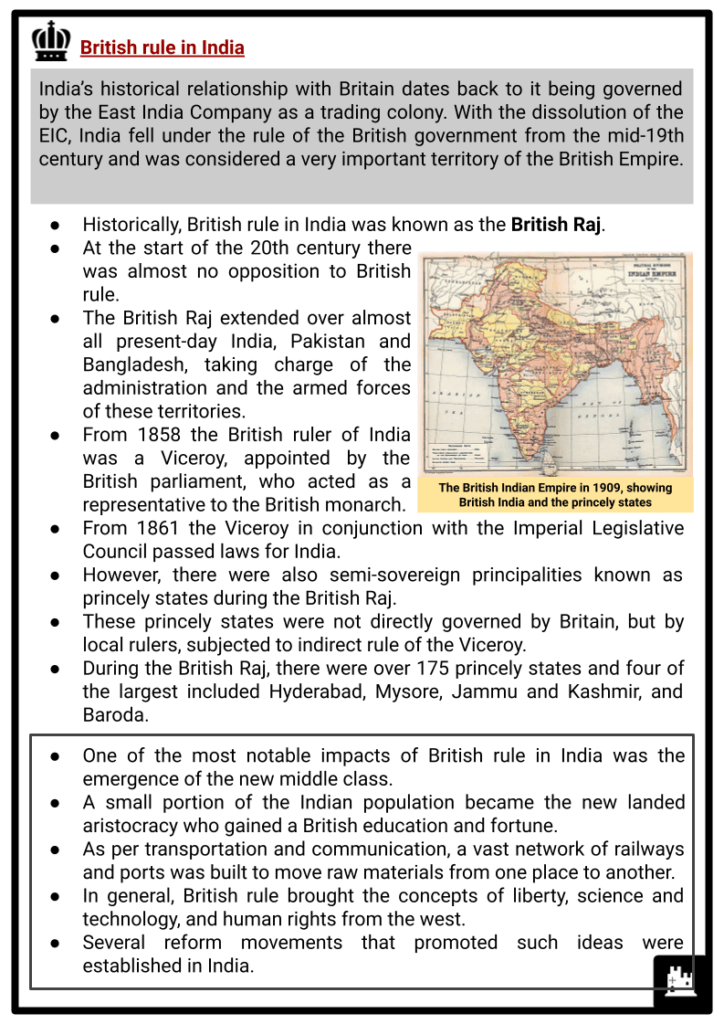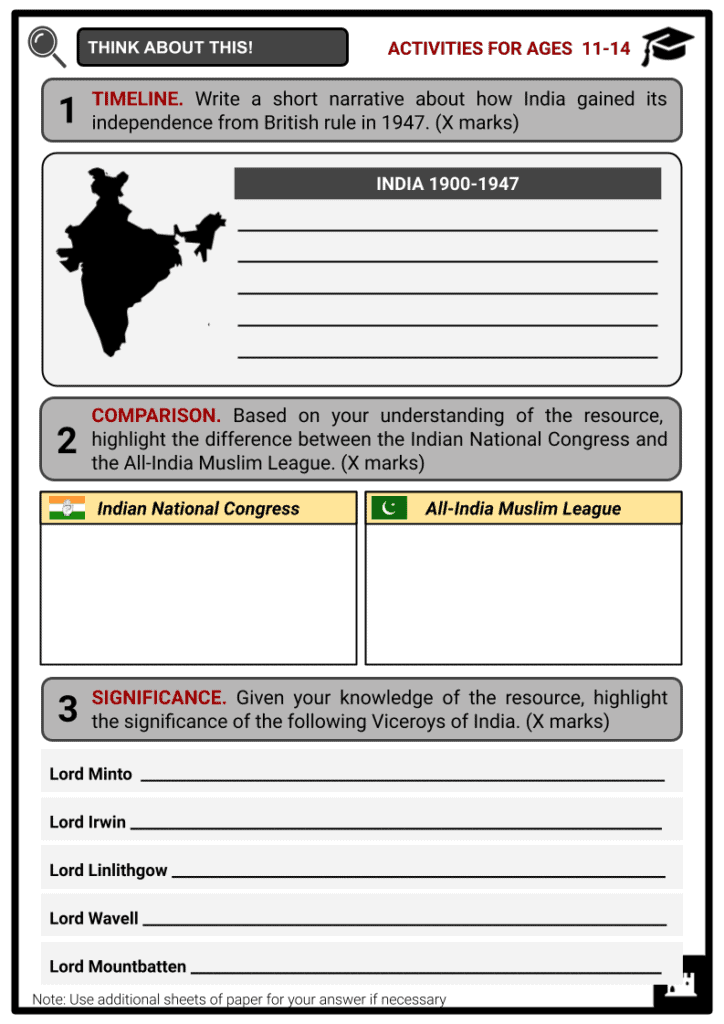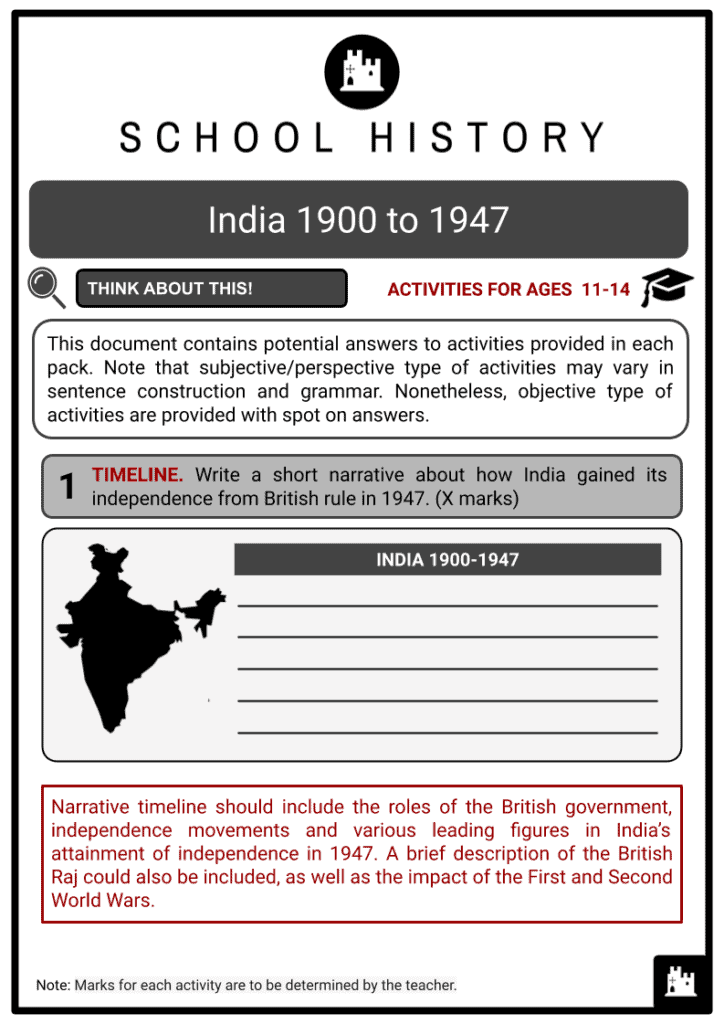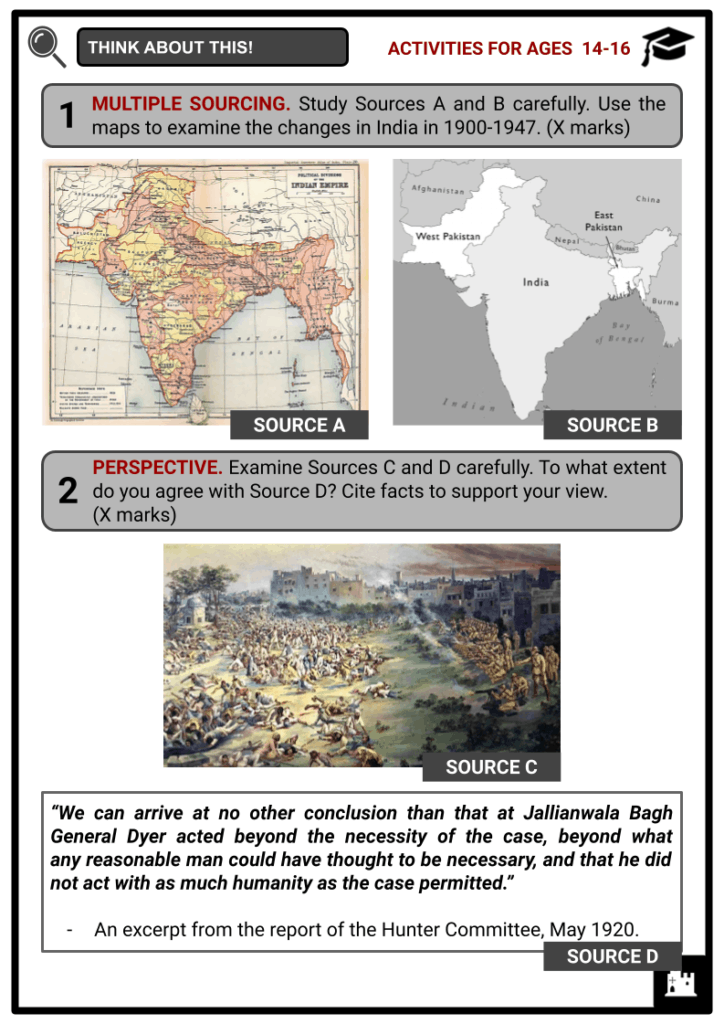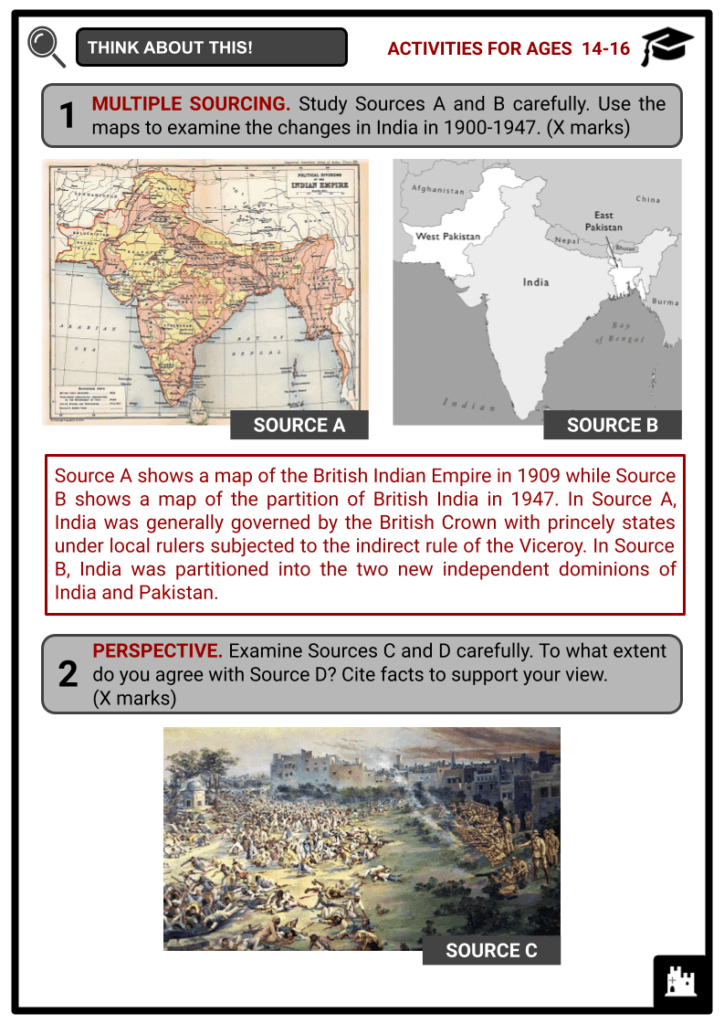Download India 1900 to 1947 Worksheets
Do you want to save dozens of hours in time? Get your evenings and weekends back? Be able to teach India 1900 to 1947 to your students?
Our worksheet bundle includes a fact file and printable worksheets and student activities. Perfect for both the classroom and homeschooling!
Table of Contents
Add a header to begin generating the table of contents
Summary
- British rule in India
- British response to the growing nationalism in India
- Gandhi and the Indian National Congress
- The Government of India Act of 1935 and the Second World War
- Independence and partition
Key Facts And Information
Let’s find out more about India 1900 to 1947!
- From 1858 until 1947, the British Crown ruled over the Indian subcontinent. Following its participation in the First World War, India fostered greater self-confidence in its ability to participate more in governmental affairs. With many Indians seeking self-determination, prominent nationalist movements and leaders organised strikes and protests to induce Britain to grant self-government to India.
- When the Second World War concluded, Britain’s Labour government under Clement Attlee favoured granting self-rule to India. However, this proved to be a complex process. Finally, in 1947, the Indian Independence Act passed by the British parliament created two new independent dominions, India and Pakistan.
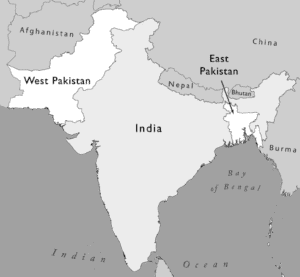
British rule in India
- India’s historical relationship with Britain dates back to it being governed by the East India Company as a trading colony. With the dissolution of the EIC, India fell under the rule of the British government from the mid-19th century and was considered a very important territory of the British Empire.
- Historically, British rule in India was known as the British Raj.
- At the start of the 20th century there was almost no opposition to British rule.
- The British Raj extended over almost all present-day India, Pakistan and Bangladesh, taking charge of the administration and the armed forces of these territories.
- From 1858 the British ruler of India was a Viceroy, appointed by the British parliament, who acted as a representative to the British monarch.
- From 1861 the Viceroy in conjunction with the Imperial Legislative Council passed laws for India.
- However, there were also semi-sovereign principalities known as princely states during the British Raj.
- These princely states were not directly governed by Britain, but by local rulers, subjected to indirect rule of the Viceroy.
- During the British Raj, there were over 175 princely states and four of the largest included Hyderabad, Mysore, Jammu and Kashmir, and Baroda.
- One of the most notable impacts of British rule in India was the emergence of the new middle class.
- A small portion of the Indian population became the new landed aristocracy who gained a British education and fortune.
- As per transportation and communication, a vast network of railways and ports was built to move raw materials from one place to another.
- In general, British rule brought the concepts of liberty, science and technology, and human rights from the west.
- Several reform movements that promoted such ideas were established in India.
- The Indian National Congress (INC) was set up in 1885.
- It was a political party and the first modern nationalist movement to emerge in the British Empire.
- It consisted of middle-class, educated Indian people who had moderate views and sought dialogue with Britain.
- However, independence was not a topic at the time of its inception.
- In 1906, the All-India Muslim League, also known as the Muslim League, was established.
- It was popular with Muslim people fearful of Hindu domination.
- They sought to protect their rights, interests and community and strongly advocated for the establishment of a separate Muslim-majority nation-state: Pakistan.
British response to the growing nationalism in India
- A set of reforms known as the Morley-Minto Reforms were introduced in 1909. Named after Viceroy Lord Minto and Secretary of State for India, John Morley, the act brought about a limited increase in the involvement of Indians in the governance of the colony after they showed dissatisfaction with the difficulty of entering into the civil service. Concession for representation was granted to the native elite.
- At the outbreak of the First World War, India showed loyalty to Britain.
- Approximately 1.3 million Indian soldiers fought for the British Army on multiple fronts.
- Around 74,000 were killed and as many were wounded.
- India’s participation in the war fostered greater self-confidence in its ability to participate more in governmental affairs.
- Britain’s response to this increased desire for power and representation was met with the Defence of India Act of 1915.
- This act served as an emergency criminal law aimed at curbing the increase in Home Rule League, or the efforts of Indian nationalists to achieve self-rule from the British Indian government.
- It granted widespread power for preventative indefinite detention, imprisonment without trial, and restrictions on freedoms such as writing, speech, and of movement.
- The act was applicable to all subjects of Britain in India and deemed necessary to protect the colony from nationalist violence.
- In August 1917, Britain thought of the idea of giving India a degree of self-government with the presentation of the Montagu Declaration in the British parliament.
- This declaration promised greater autonomy in Indian politics and administration.
- This would lead to the gradual development of self-governing institutions, which in turn would lead to a progressive realisation of a government in India.
- The optimism brought by this declaration was later crushed with the passage of the Rowlatt Acts.
- In February 1919, the powers of the Defence of India Act of 1915 were further extended by the Imperial Legislative Council in the form of the Rowlatt Acts.
- Also known as the Anarchical and Revolutionary Crimes Act or Black Act, the Rowlatt Acts indefinitely extended emergency measures of preventive detention, incarceration without trial and judicial review.
- This rather proved that Britain was prepared to be autocratic to maintain its power. This caused massive unrest in India.
- Riots eventually broke out, the most infamous being at Amritsar in Punjab in April 1919, where an estimated 379 unarmed protesters were killed by British soldiers while a further 1,200 were injured.
- Acting Brigadier-General Reginald Dyer felt justified in his actions because the people of Amritsar disobeyed a ban on all meetings.
- Dyer was initially considered a hero by British Lords who benefited from British rule in India, but was largely condemned by the House of Commons and many Indian people.
- Many were angry when he simply resigned and was not charged with murder nor presented before a martial court.
- In December 1919 the British parliament passed the Government of India Act.
- It emerged from the Montagu Declaration and hoped to bring about a new era of cooperation between the British and Indians.
- The act included an introduction of a national parliament with two houses for India.
- This gave about five million of the wealthiest Indians the right to vote, which was a very small percentage of the total population.
- Indian nationals would also be present in the provincial government, ministry of education, health and public works.
- Despite the act’s aim to increase Indian participation in the decision-making process, cooperation was looking increasingly unlikely due to the timing of the act.
- In addition, the British still controlled the central government and had some element of control in the provincial governments.
- The majority of Members of Parliament in Britain were not in favour of giving India any form of self-government, as this might begin the fall of the British Empire.
Gandhi and the Indian National Congress
- Many Indians felt a sense of determination to eliminate British rule and so rushed to join the INC, which quickly became the party of the masses. By 1915, Mahatma Gandhi was respected and had an international reputation as an Indian nationalist leader and community organiser. Upon joining the INC, he was influenced by the restraint and moderation of its party leader.
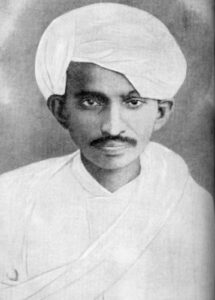
- In 1920, Gandhi took over leadership of the INC and persuaded many of his followers to use passive resistance and non-violence in their protests.
- Occurring from 1920 to 1922, many Indians participated in sit-down strikes, refused to work and refused to pay taxes.
- This was one of Gandhi’s first organised acts of large-scale civil disobedience or satyagraha, to induce the British to grant self-government to India.
- After the killing of police officers by an angry mob in the village of Chauri Chaura in February 1922, Gandhi called off the non-cooperation movement.
- The following month, he was arrested without incident and was imprisoned for almost two years.
- In his absence, two individuals emerged in the INC: father and son Motilal and Jawaharlal Nehru. Motilal led the Swaraj Party or Home Rule and Jawaharlal led the non-cooperation movement.
- In 1928 at the INC’s annual conference, it was suggested that India demand total independence from Britain within a year. If Britain did not cooperate, another campaign of disruption would ensue.
- Come December 1929, with Britain not accepting the INC’s demands, the INC under Nehru declared 26 January 1930 as India’s Independence Day and Gandhi embarked on a second satyagraha campaign.
- The campaign of civil disobedience began with the Salt March that occurred from 12 March to 6 April 1930.
- Participants opposed taxation and the British monopoly on salt by walking a total of 240 miles from Sabarmati Ashram to Dandi.
- Initially small, the number of participants grew along the way.
- Gandhi, along with 60,000 others, was arrested in May 1930 for his actions, and it drew worldwide attention.
- He was later invited to the Second Round Table Conference in 1931.
- This conference was organised by Lord Irwin, a sympathetic Viceroy to India.
- Occurring from 1920 to 1922, many Indians participated in sit-down strikes, refused to work and refused to pay taxes.
- This was one of Gandhi’s first organised acts of large-scale civil disobedience or satyagraha, to induce the British to grant self-government to India.
- After the killing of police officers by an angry mob in the village of Chauri Chaura in February 1922, Gandhi called off the non-cooperation movement.
- The following month, he was arrested without incident and was imprisoned for almost two years.
- In his absence, two individuals emerged in the INC: father and son Motilal and Jawaharlal Nehru. Motilal led the Swaraj Party or Home Rule and Jawaharlal led the non-cooperation movement.
- In 1928 at the INC’s annual conference, it was suggested that India demand total independence from Britain within a year. If Britain did not cooperate, another campaign of disruption would ensue.
- Come December 1929, with Britain not accepting the INC’s demands, the INC under Nehru declared 26 January 1930 as India’s Independence Day and Gandhi embarked on a second satyagraha campaign.
- The campaign of civil disobedience began with the Salt March that occurred from 12 March to 6 April 1930.
- Participants opposed taxation and the British monopoly on salt by walking a total of 240 miles from Sabarmati Ashram to Dandi.
- Initially small, the number of participants grew along the way.
- Gandhi, along with 60,000 others, was arrested in May 1930 for his actions, and it drew worldwide attention.
- He was later invited to the Second Round Table Conference in 1931.
- This conference was organised by Lord Irwin, a sympathetic Viceroy to India.
The Government of India Act of 1935 and the Second World War
- In the wake of the failed Round Table Conferences, Britain enacted changes to how India was run and approved the Government of India Act in 1935.
- Some but not all the elements were introduced by the Government of India Act.
- An elected Indian assembly would have a say in everything apart from defence and foreign affairs.
- The provincial assemblies were in full control of their local affairs.
- The Indian nationalists were not satisfied with this as they were not allowed to control their own defence and foreign policies.
- Princes who were still in control of some areas in India refused to cooperate with the newly formed provincial assemblies, so what they had agreed to was meaningless.
- A major failing of the act was that it had ignored the obvious religious rivalry between Muslims and Hindus.
- Nearly two-thirds of India’s population were Hindus, and Muslims feared that they would be treated unfairly once they were granted independence.
- For instance, in the 1937 provincial elections, Hindus dominated the INC and won eight out of the eleven possible provinces.
- The Muslim League, under Mohammed Ali Jinnah, now demanded a separate region, which was to be called Pakistan.
- However, Gandhi and the INC were determined to maintain a united Indian front.
- Hindu-Muslim tensions began to grow.
- The Second World War concealed this disparity but only temporarily.
- In 1939, when Britain declared war on Germany, Viceroy of India, Lord Linlithgow, also declared war, failing to consult with the Indian Assembly first.
- The INC had mixed feelings about the war. It objected to not being consulted.
- Leaders like Gandhi were pacifists while Nehru was anti-fascist and believed India should support Britain but through its own choice.
- Indians wanted swaraj in exchange for aid in the Second World War.
- On the other hand, the Muslim League supported Britain’s declaration of war.
- When the INC left the government in protest, Jinnah was thrilled and began to forward demands of Muslims, which by 1940 included a separate Muslim state.
- When Britain refused to acknowledge the INC, Gandhi launched the Quit India Movement in 1942. This saw tens of thousands of Indian leaders imprisoned by the British.
- Meanwhile, an army of Indian prisoners of war captured by Japan in the Asian theatre of WWII were set against Britain.
- In 1943 a major famine in Bengal killed millions. It remains especially controversial because of Churchill’s refusal to provide food relief.
- When the Second World War ended, Britain was heavily put back economically and India emerged as the world’s fourth largest industrial power.
Independence and partition
- In 1945, Indian political leaders were released from jail and the Viceroy of India, Lord Wavell, set up a meeting with them, called the Simla Conference. The aim was to agree on and approve the Wavell Plan for Indian self-government.
- While the Simla Conference’s aim was to reach agreement for self-rule and provide for separate representation for Muslims, talks stalled on the issue of the selection of Muslim representatives.
- Since the Muslim League refused to have INC represent them, the conference fell apart and the last hopes of a united India went with it.
- Meanwhile, back in Britain, the July 1945 general elections were held and Labour won. Churchill was out and Clement Attlee was in.
- The INC was optimistic that the Labour government, which was sympathetic to India, would help the country move towards self-rule.
- The Labour government allowed the planned Indian elections of 1945-46 to take place in order to determine public appetite for independence.
- The Muslim League won all 30 seats reserved for Muslims in the Central Assembly.
- There were also riots and a mutiny by the navy and army.
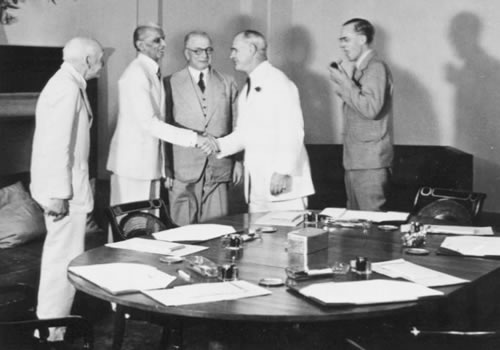
- Through the combination of the Labour government wanting to transfer power over to the Indians as quickly as possible, the election results and the increasing unrest in India, Attlee created the Cabinet Mission in the hopes of solving the problems in India.
- The three-man group stayed in India for three months and hoped to grant independence and keep India united.
- Jinnah demanded that Pakistan be created and be comprised of six provinces. These demands were opposed by the INC.
- The Cabinet Mission also preferred a united India for strategic reasons.
- The Cabinet Mission proposed:
- Immediate full dominion status for India with protection for Muslims.
- A central government responsible for foreign policy, defence and internal communication.
- Provincial governments responsible for education, health, police health and public works.
- Provinces would be allowed to combine and develop common policies.
- Both the INC and the Muslim League accepted the proposals.
- The INC approved of a united India plan, while the Muslim League liked that it could have its own state within India.
- Elections for the new assembly were then held in which INC won 205 seats and the Muslim League won 73.
- After the elections, the INC used its strength to declare that it was not bound by the Cabinet Mission’s proposals.
- It suggested that the idea of a separate state of Pakistan fall away. Jinnah rejected this suggestion.
- Angered at the INC’s actions, Jinnah called for Muslims to have a Direct Action day on 16 August 1946.
- The Direct Action was supposed to be a series of peaceful demonstrations.
- Instead, it turned into three days of rioting and violence against Hindus in Calcutta that left 5,000 dead, 20,000 injured and 100,000 homeless.
- It also served as a precursor to more violence in Sindh and Bengal.
- The British were unable to stop the violence even when the Muslims turned on the army and police.
- Britain and Congress blamed Jinnah and the Muslim League for the violence that broke out around Direct Action.
- In the aftermath, Viceroy Wavell asked Nehru to become the prime minister of India.
- Nehru accepted and took the post in September 1946.
- Jinnah and the Muslim League were appalled by the violence and thus agreed to join the interim government.
- It quickly became clear that the INC and the Muslim League could not work together, though, and violence continued to spread across India.
- Concerned about the escalating violence in India, Attlee announced early in 1947 that Britain would leave India by June 1948 and a new Viceroy was appointed, Lord Mountbatten.
- He concluded that peace and harmony could only be achieved if a partition was allowed. The Hindus agreed with him.
- To prevent violence caused by any delay, he pushed forward the date for Britain leaving India to August 1947.
- The Indian Independence Act was signed in August 1947. It separated the Muslim majority areas (in the north-western and north-eastern regions of India) from India and the independent state of Pakistan was created.
- This new state, Pakistan, was split in two, 1,000 miles apart.
- The act proved difficult to put into action.
- Some people found themselves on the wrong side of the partition, especially in the mixed provinces of Punjab and Bengal.
- Millions had to move to the new frontiers, whereby Hindus in what was to become Pakistan moved to India while Muslims in India moved to Pakistan.
- The two moving groups inevitably met and violence ensued especially in the volatile Punjab province where it is thought that 250,000 people were murdered in religious clashes.
- By the end of 1947, it seemed that the violence would get worse, but in January 1948 Gandhi was assassinated by a fellow Hindu.
- It was a gesture that showed that Hindus were fed up with Gandhi’s tolerance of Muslims.
- However, this assassination ironically ushered in a period of stability due to the shock of his death.

